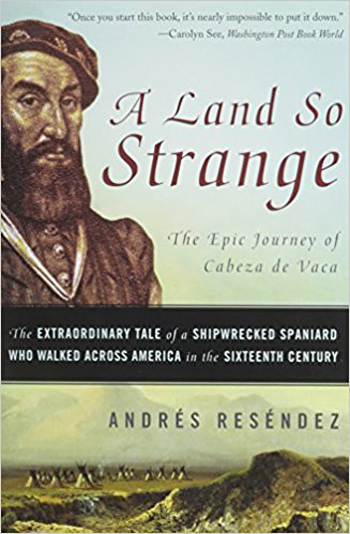Book reviews
 |
 |
 |
 |
 |
 |
 |
‘A Land So Strange’
Book review of A Land so Strange, the Epic Journey of Cabeza de Vaca
by Andres Resendez, New York: Basic Books, 2009, 314 pp.
by Andres Resendez, New York: Basic Books, 2009, 314 pp.
In the Spring of 1536 four Spaniards on a slaving raid in Northwest Mexico encountered one of the most bizarre sights they could have imagined. A white man, clad in skins and with a beard hanging to his waist, approached them with an entourage of natives and one African. He spoke perfect Spanish. Indeed, it was none other than Álvar Núñez Cabeza de Vaca, royal treasurer and one of the only survivors of the Panfilo de Narvaez expedition to explore the unknown territory called La Florida; at the time everything between present day Texas and Florida.
Cabeza de Vaca and his companions had struggled for eight years to make it back to Spanish lands. Their adventure had seen them through the hurricanes of the Caribbean, the jungles of Florida, the Gulf of Mexico and the deserts of the Southwest. On this journey they encountered innumerable native tribes never before seen by white men as well as the most astonishing natural wonders. It was, in the words of Cabeza de Vaca, “A land so strange.”
The book A Land So Strange is the historical narrative of the doomed Narvaez expedition and the incredible journey of the survivors. A true story, it vividly relates an incredible adventure, demonstrating the resourcefulness of men pushed to the very brink. It is a story of bravery, disaster and, above all, Faith.
The fate of the Narvaez expedition
The Narvaez expedition, a Spanish adventure which set out to colonize La Florida, was a horrible failure. After being devastated by hurricanes in Cuba, the ships were pushed off course by the Gulf Stream Current. When they landed in Florida, they mistakenly believed it to be Texas and set out on foot to conquer it.
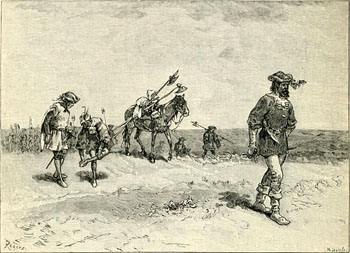 Unlike the Indians of Mexico, the natives of Florida fought successful guerilla wars. After harrowing losses, starvation and illness, the Spaniards decided to return to the ships. When the ships could not be found, the survivors had no choice but to face a grim reality: They would have to make the 1,500 mile trek to the nearest Spanish settlement on their own.
Narvaez had embarked with five ships and 600 men; 300 survived to disembark on those strange Florida shores. In the end only four would live: Álvar Núñez Cabeza de Vaca, Alonso del Castillo Maldonado, Andrés Dorantes de Carranza and the black slave Estebanico. A Land So Strange recounts their remarkable story.
Unlike the Indians of Mexico, the natives of Florida fought successful guerilla wars. After harrowing losses, starvation and illness, the Spaniards decided to return to the ships. When the ships could not be found, the survivors had no choice but to face a grim reality: They would have to make the 1,500 mile trek to the nearest Spanish settlement on their own.
Narvaez had embarked with five ships and 600 men; 300 survived to disembark on those strange Florida shores. In the end only four would live: Álvar Núñez Cabeza de Vaca, Alonso del Castillo Maldonado, Andrés Dorantes de Carranza and the black slave Estebanico. A Land So Strange recounts their remarkable story.
How did they survive? At the beginning, some Indians offered hospitality to the stranded Europeans. Cabeza de Vaca and the other three survivors were kept alive by the generosity of natives, but, as the novelty of the Europeans wore off, this kindliness mutated into a brutal slavery. They suffered in that misery for six long years. It was during this ruthless time, however, that they would acquire a curious reputation that finally gained them freedom.
Healers who came from the sun
The native tribes of America at this time were deeply fixed in a mixed shamanism that centered around medicine men. To them everything had a spiritual power and they believed that the shaman or witch doctor could manipulate these powers. Some natives took these light-skinned foreigners to be “children of the sun” and demanded that they perform healings.
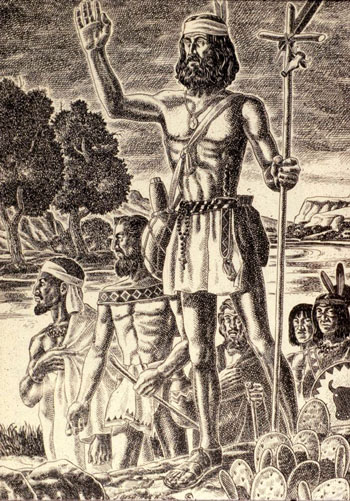 With little choice, Cabeza de Vaca and his companions made the Sign of the Cross and prayed to God that the suffering Indians be delivered from their illnesses. What resulted bordered on the miraculous! Through prayer and the Sign of the Cross, Cabeza de Vaca and his companions were able to heal.
With little choice, Cabeza de Vaca and his companions made the Sign of the Cross and prayed to God that the suffering Indians be delivered from their illnesses. What resulted bordered on the miraculous! Through prayer and the Sign of the Cross, Cabeza de Vaca and his companions were able to heal.
After meticulous planning, the survivors were able to escape their captors. Their reputation preceded them and the four survivors were welcomed enthusiastically by neighboring tribes, who also demanded the "healings." With each healing their fame grew and soon they were traveling from tribe to tribe, as they moved south towards Spanish lands.
While the natives revered them nearly as gods, Cabeza de Vaca and the others saw this incredible gift as a manifestation of God’s designs for North America. The Spaniards believed themselves to be mere tools in God’s plans, calling the healings “the wonders that Our Lord was working through us.” (page 173). Lest they presume, they also worried their sins would impede God’s grace, fearing “sins would prevent the cures from turning out well every time.”(p. 175).
Finally, they saw their healing powers as a saving grace from God, Who had provided a way for them to be welcome in this "strange land" amongst the often cruel and hard hearted natives: “In this way Jesus Christ guided us and His infinite mercy was with us, opening roads where there were none.” (p. 167)
In fact, one of these healings would lead to the historic first surgery in North America. An Indian, pierced by an arrow, lay dying; Cabeza de Vaca carefully cut open the wound to remove the arrowhead and stitch the wound closed. To this day Cabeza de Vaca is honored as the patron of surgeons in the Lone Star State. This remarkable episode is deserving of an article of its own.
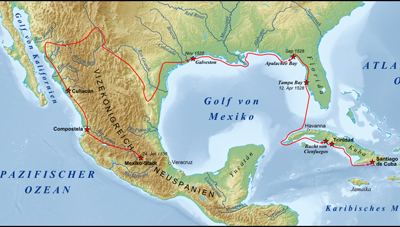 With their status as healers, the four made it to within 100 miles of Spanish territory. At last, after so many years, they were within reach of civilization, yet then it was when the daring spirit of the conquistador shone through most. In a bold move, turning their back on the safety of their old lives, the four changed course to continue to explore the unknown. With the Southwest beckoning, the four survivors travelled deeper into these uncharted territories with the sole aim of exploration.
With their status as healers, the four made it to within 100 miles of Spanish territory. At last, after so many years, they were within reach of civilization, yet then it was when the daring spirit of the conquistador shone through most. In a bold move, turning their back on the safety of their old lives, the four changed course to continue to explore the unknown. With the Southwest beckoning, the four survivors travelled deeper into these uncharted territories with the sole aim of exploration.
These survivors were the first Europeans to see the American Southwest. There they met new tribes, encountered new plants and animals and even found Indians who cultivated corn and cotton. Finally, they met up with astonished Spanish slavers not far from the Pacific Ocean. It had been over eight years since they had set out from Spain on their fateful journey.
Not so noble savages
Cabeza de Vaca’s testimony renders a unique insight into the pre-Columbian Indians. In Florida they encountered the outskirts of a culture that would soon collapse and leave only traces of its former existence. In the Southwest they found a culture crumbling under the pressures of slavers and disease.
The Spaniard’s notes also lay a death blow to the myth of the Noble Savage disseminated later by Rousseau. Some Indians were respectful of the Spaniards. Others attacked on sight, trying to kill them for little or no reason. One raft of weakened Spaniards was entirely wiped out when they were too starved to defend themselves.
Cabeza de Vaca recounts many of the cultural practices of the Indians, showing them to be primitive, petty and superstitious to the point of killing family members (even children) over so much as a bad dream. Infanticide (particularly regarding girls) was common and women were treated cruelly. The elderly were seen as useless.
The spirit of adventure
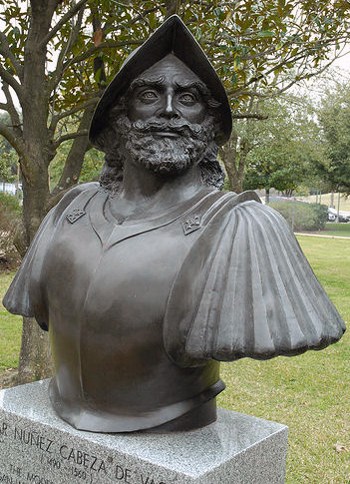 The story of the Narvaez expedition is a testament to human ambition and cleverness. These brave Europeans, set against the most tremendous odds, managed to carve out an existence for themselves in a strange and alien world. With incredible determination, this brave band set out from Europe, crossed the vast Atlantic Ocean, landed on uncharted shores and crossed hundreds of miles, enduring the most dreadful privations.
The story of the Narvaez expedition is a testament to human ambition and cleverness. These brave Europeans, set against the most tremendous odds, managed to carve out an existence for themselves in a strange and alien world. With incredible determination, this brave band set out from Europe, crossed the vast Atlantic Ocean, landed on uncharted shores and crossed hundreds of miles, enduring the most dreadful privations.
They saw things that no Europeans had even dreamed. Animals unlike any they had seen before. In the Southwest they encountered more curiosities and wonders, glimpsing the last vestiges of tribes that would soon be wiped out or altered beyond recognition. Nor did they lose sight of their Heaven-sent mission, to bring healing to the natives in the Sign of the Cross with the hope of preparing them to receive the word of God.
Narvaez and his expedition are long gone, but through their narrative we get a glimpse into the world as it once was in a way never imagined. It was an age of brutality and suffering, but also a world of aspiration, bravery, wonder and faith. Perhaps, the title A Land So Strange can bear a different significance to us living now in a world steeped in godless hedonism: the whole world, mentality and spirit of the 16th century Spaniards – Catholic to their very bones – signifies A Land So Strange.
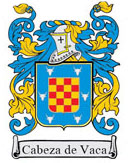

Cabeza de Vaca and his companions had struggled for eight years to make it back to Spanish lands. Their adventure had seen them through the hurricanes of the Caribbean, the jungles of Florida, the Gulf of Mexico and the deserts of the Southwest. On this journey they encountered innumerable native tribes never before seen by white men as well as the most astonishing natural wonders. It was, in the words of Cabeza de Vaca, “A land so strange.”
The book A Land So Strange is the historical narrative of the doomed Narvaez expedition and the incredible journey of the survivors. A true story, it vividly relates an incredible adventure, demonstrating the resourcefulness of men pushed to the very brink. It is a story of bravery, disaster and, above all, Faith.
The fate of the Narvaez expedition
The Narvaez expedition, a Spanish adventure which set out to colonize La Florida, was a horrible failure. After being devastated by hurricanes in Cuba, the ships were pushed off course by the Gulf Stream Current. When they landed in Florida, they mistakenly believed it to be Texas and set out on foot to conquer it.

The survivors of the Narvaez expedition start out on the long 1,500 mile trek - only four would survive
How did they survive? At the beginning, some Indians offered hospitality to the stranded Europeans. Cabeza de Vaca and the other three survivors were kept alive by the generosity of natives, but, as the novelty of the Europeans wore off, this kindliness mutated into a brutal slavery. They suffered in that misery for six long years. It was during this ruthless time, however, that they would acquire a curious reputation that finally gained them freedom.
Healers who came from the sun
The native tribes of America at this time were deeply fixed in a mixed shamanism that centered around medicine men. To them everything had a spiritual power and they believed that the shaman or witch doctor could manipulate these powers. Some natives took these light-skinned foreigners to be “children of the sun” and demanded that they perform healings.

Cabeza de Vaca and his companions, considered healers, were accompanied by Indians
After meticulous planning, the survivors were able to escape their captors. Their reputation preceded them and the four survivors were welcomed enthusiastically by neighboring tribes, who also demanded the "healings." With each healing their fame grew and soon they were traveling from tribe to tribe, as they moved south towards Spanish lands.
While the natives revered them nearly as gods, Cabeza de Vaca and the others saw this incredible gift as a manifestation of God’s designs for North America. The Spaniards believed themselves to be mere tools in God’s plans, calling the healings “the wonders that Our Lord was working through us.” (page 173). Lest they presume, they also worried their sins would impede God’s grace, fearing “sins would prevent the cures from turning out well every time.”(p. 175).
Finally, they saw their healing powers as a saving grace from God, Who had provided a way for them to be welcome in this "strange land" amongst the often cruel and hard hearted natives: “In this way Jesus Christ guided us and His infinite mercy was with us, opening roads where there were none.” (p. 167)
In fact, one of these healings would lead to the historic first surgery in North America. An Indian, pierced by an arrow, lay dying; Cabeza de Vaca carefully cut open the wound to remove the arrowhead and stitch the wound closed. To this day Cabeza de Vaca is honored as the patron of surgeons in the Lone Star State. This remarkable episode is deserving of an article of its own.

Landing in Cuba, Cabeza de Vaca 's started on his incredible journey of exploration
These survivors were the first Europeans to see the American Southwest. There they met new tribes, encountered new plants and animals and even found Indians who cultivated corn and cotton. Finally, they met up with astonished Spanish slavers not far from the Pacific Ocean. It had been over eight years since they had set out from Spain on their fateful journey.
Not so noble savages
Cabeza de Vaca’s testimony renders a unique insight into the pre-Columbian Indians. In Florida they encountered the outskirts of a culture that would soon collapse and leave only traces of its former existence. In the Southwest they found a culture crumbling under the pressures of slavers and disease.
The Spaniard’s notes also lay a death blow to the myth of the Noble Savage disseminated later by Rousseau. Some Indians were respectful of the Spaniards. Others attacked on sight, trying to kill them for little or no reason. One raft of weakened Spaniards was entirely wiped out when they were too starved to defend themselves.
Cabeza de Vaca recounts many of the cultural practices of the Indians, showing them to be primitive, petty and superstitious to the point of killing family members (even children) over so much as a bad dream. Infanticide (particularly regarding girls) was common and women were treated cruelly. The elderly were seen as useless.
The spirit of adventure

A monument to Cabeza de Vaca in Houston
They saw things that no Europeans had even dreamed. Animals unlike any they had seen before. In the Southwest they encountered more curiosities and wonders, glimpsing the last vestiges of tribes that would soon be wiped out or altered beyond recognition. Nor did they lose sight of their Heaven-sent mission, to bring healing to the natives in the Sign of the Cross with the hope of preparing them to receive the word of God.
Narvaez and his expedition are long gone, but through their narrative we get a glimpse into the world as it once was in a way never imagined. It was an age of brutality and suffering, but also a world of aspiration, bravery, wonder and faith. Perhaps, the title A Land So Strange can bear a different significance to us living now in a world steeped in godless hedonism: the whole world, mentality and spirit of the 16th century Spaniards – Catholic to their very bones – signifies A Land So Strange.


Posted June 21, 2017
______________________
______________________
 Volume I |
 Volume II |
 Volume III |
 Volume IV |
 Volume V |
 Volume VI |
 Volume VII |
 Volume VIII |
 Volume IX |
 Volume X |
 Volume XI |
 Special Edition |
